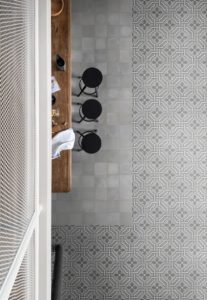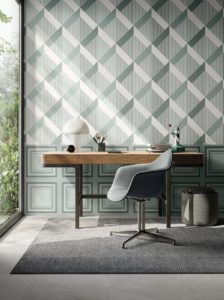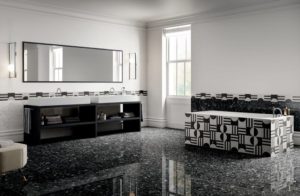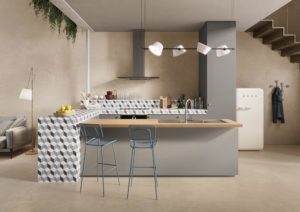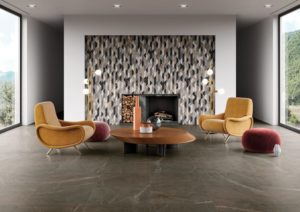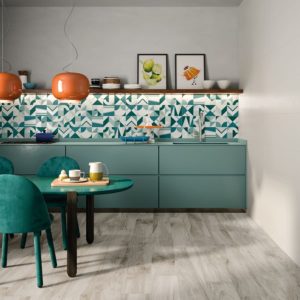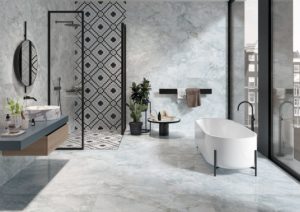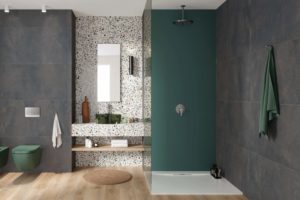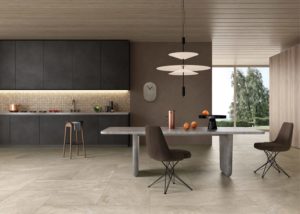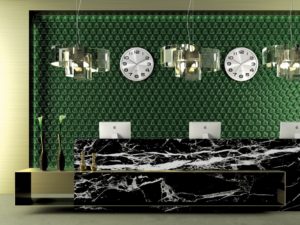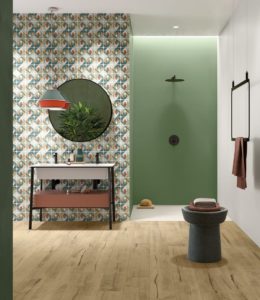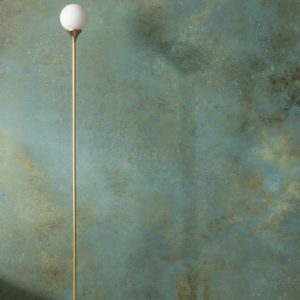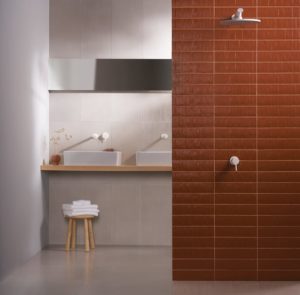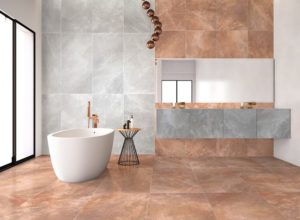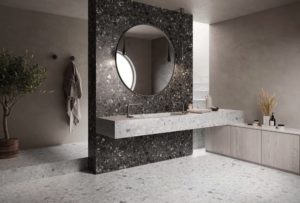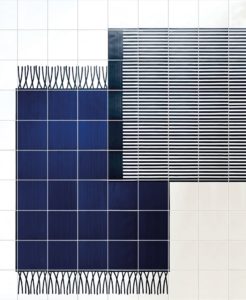Products Trends


Ceramic tile as a design element | by Antonia Solari
Porcelain tiles and slabs are now expanding their fields of application to include interior design, furnishings and architectural uses. Rather than just a simple and practical solution for floor and wall coverings, they are becoming essential compositional elements in their own right, ideal for architectural or interior design project.
Tiles with alternating colours and finishes are capable of transforming walls into a kind of interior landscape, while porcelain surfaces are increasingly used for furnishing applications such as tables and kitchen countertops, shelves and seats. They have even become the canvases used by designers to create original ceramic carpets. And last but not least, coloured tiles – often chosen in dense, saturated tones – can be used as a means of separating spaces with different functions: the boundary between two different colours can signify the end of one functional area and the beginning of another.
Mindful of these new roles of porcelain, manufacturers are proposing their collections in numerous versions to allow designers to give free rein to their creativity while remaining within the confines of a single series. As a result, the latest tile collections no longer come solely in matching shades but also include contrasting colours, decorations and designs so that an entire project – even one with alternating colours and patterns – can be completed using products from a single supplier.
Consequently, producers are continuing to include wood or marble effect porcelain, slabs recreating continuous surfaces and popular designs such as terrazzo in their ranges, often enhanced by new non-slip finishes or reduced thicknesses and equipped with new functions tailored to the different applications. In the bathroom for example, the shower area may feature tiles of one colour and the washbasin area another in a contrasting shade. In an open plan living space, the separation between the kitchen area and the living room may be marked by the choice of colour, size and finish of the wall tiles, or in another example, the tiled back of a bookcase may be chosen in a different colour to that of the remaining walls.
- 01.
- 02.
- 03.
01. Marazzi’s StepWise technology produces tiles with high slip resistance combined with a soft-touch surface. The photo shows the Crogiolo D_Segni Blend porcelain collection inspired by 20×20 cm handmade cement tiles. Available in 7 colours and 18 designs to create a surface with a powerful graphic effect.
02. Panaria Ceramica’s Glam collection consists of porcelain surfaces that recreate the effect of wallpaper. Produced in a 3.5 mm thickness, it is available with 14 decorative themes ideal for rooms with a strong personality.
03. The Victory glazed porcelain tile collection from Elios Ceramica stands out for its vibrant, fragmented surface with gently undulating relief. It comes in ten colours and two decorations in the form of a 6.1×37 cm strip with a 6 mm thickness.
- 04.
- 05.
- 06.
04. Inspired by high-quality marble and granite, the various surfaces in the Opulence collection from Ceramiche Piemme are designed to be used in combination to decorate rooms with geometric effects. The collection consists of five colours, four sizes and three types of decoration: inlay, digital and third fire effect.
05. The Totalook series from Emilceramica includes resin-inspired versions such as TotalResin, ResinSoft, ResiNatural and Resin Tecnica designed to be used in conjunction with the TotalBrick majolica-effect line, available in 6×24 cm sizes and matt and lux finishes. The juxtaposition of the continuous surface effect and the multicoloured tiles creates a striking contrast.
06. Soapstone, Cercom’s collection inspired by steatite, a stone widely used to make artistic and handcrafted objects, is available in the four different colours Ivory, Coffee, Grey and Black as well as five sizes, from 120×120 cm down to the classic 60×60 cm.
- 07.
- 08.
- 09.
07. The Hub collection from Naxos stands out for its bold colours and clear, often graphic designs. It was developed to create visually striking walls characterised by contrasts of materials and the various available finishes: satin, pearly grits and sugar effect. Hub comes in 16 colours for white body wall tiles, 5 colours for porcelain and 8 decorations.
08. The Archimarble collection by Cerdisa is devoted entirely to marble. It comes in six different marble versions, six rectified sizes and two surface finishes, natural and lux. In an artful play of contrasts, pure, luminous whites are juxtaposed with deep blacks with white veins.
09. Blend from ABK, shown here in the colour Concrete Iron, is a concrete-look porcelain enhanced by graphic reproductions of tiny pebbles. A reworking of terrazzo, Blend comes in three finishes: natural, lapped and the innovative P-tech, which offers improved anti-slip performance on floors.
- 10.
- 11.
- 12.
10. Lea Ceramiche’s Anthology collection features five completely different motifs inspired by materials such as marble and stone and produced using technologies specially designed to create a realistic and three-dimensional surface effect.
11. LaFaenza’s range is being expanded with the addition of Vis, a surface covering available in a single 6.5 mm thickness and five sizes ranging from 120×240 cm to 60×60 cm. The collection comes in six colours: Verde Militare, Middle Grey, Argento, Bianco, Almond and Taupe.
12. With the new Del Conca House collection from Ceramica Del Conca, porcelain takes on a vital role in interior design projects. The collection consists of a system of indoor and outdoor furnishings made of porcelain (including washbasins, benches, seats, tables, kitchens and lamps) and allows for numerous combinations of surfaces and colours.
- 13.
- 14.
- 15.
13. The hexagon and rhombus are the two geometric shapes on which EtruriaDesign’s Concetto Spaziale line is based, inspired by the work of Lucio Fontana and characterised by a high gloss level achieved by bell application of a large quantity of glaze.
14. With its saturated colours and creative decorations, the Spring collection from Ceramica Sant’Agostino is designed to be used in combination with the company’s other series. This results in vibrant spaces where colour and surface coverings take on the role of design and compositional elements.
15. The Verderame finish is the latest addition to the Ossido collection of large from Laminam, extra-thin porcelain surfaces with a finish inspired by the handcrafted textures of iron.
- 16.
- 17.
- 18.
16. The Matter collection from Settecento reinterprets ceramic as a plastic material. The photo shows the Rope version on the floor and Orange Stick on the wall.
17. The Helite collection from Gambini comes in the Himalaya and Bali versions inspired by different types of salt: salmon pink for Himalaya and grey for Bali. The collection includes five colours (also Guérande, Persia and Murray) and a series of decorations and trim pieces in cold and warm colours.
18. Digital technology is used to create NovaBell’s Thermae travertine-effect porcelain collection, which reproduces the original material’s veins, bas-reliefs and colours on floors and walls. The collection comes in two sizes, 60×120 cm and 30×60 cm.
- 19.
- 20.
19. The Macro Bianco and Macro Carnico, collections from Casalgrande Padana revisit the granite effect in four different colours (Bianco, Grigio, Moro and Carnico) and four sizes with natural or glossy surfaces. As can be seen in the photo, when laid side by side they create eye-catching effects while at the same time marking a visual separation between different functional areas.
20. The Carpet collection designed by Giuliano Andrea Dell’Uva for Ceramica Francesco de Maio consists of overlapping ceramic rugs in colours inspired by Mediterranean houses. The tiles are hand decorated and suitable for both indoor and outdoor use.
October 2020





